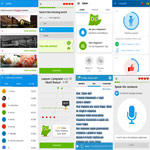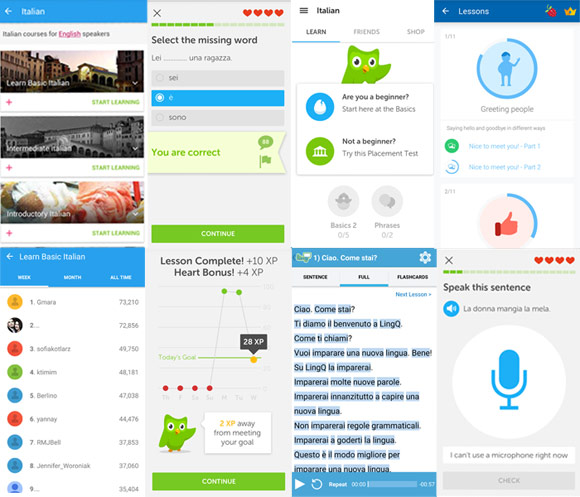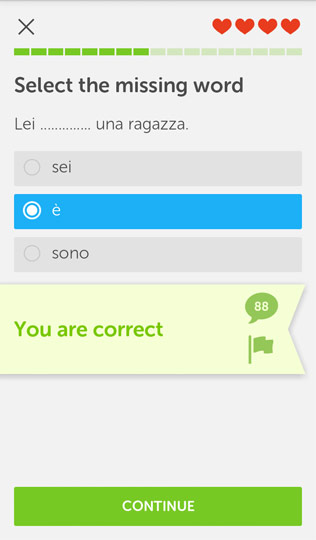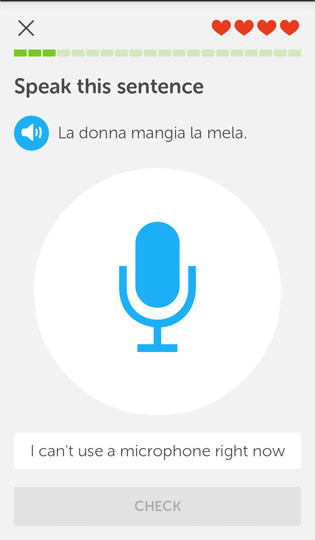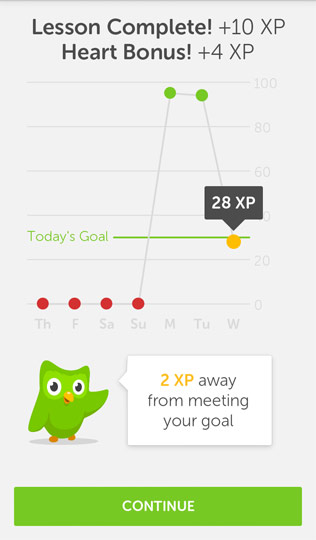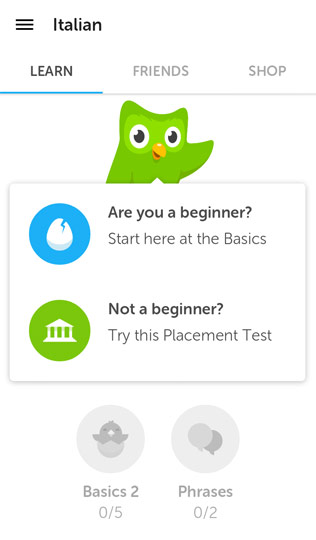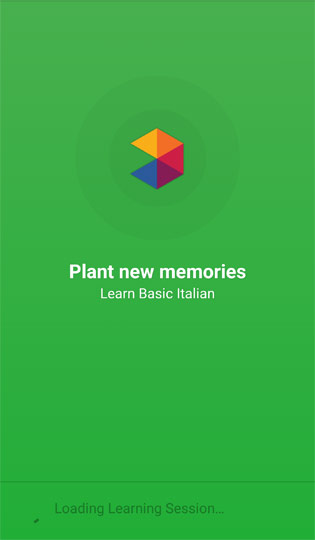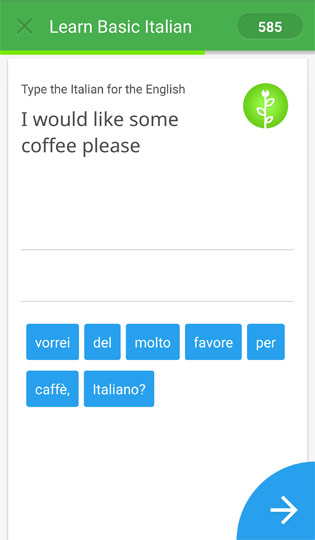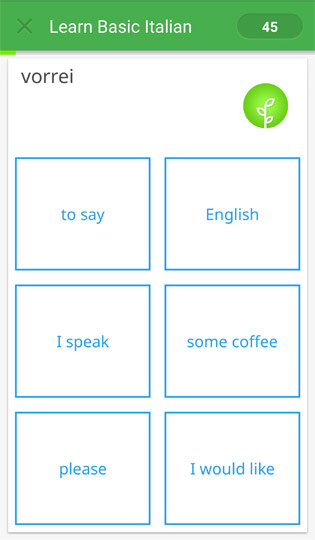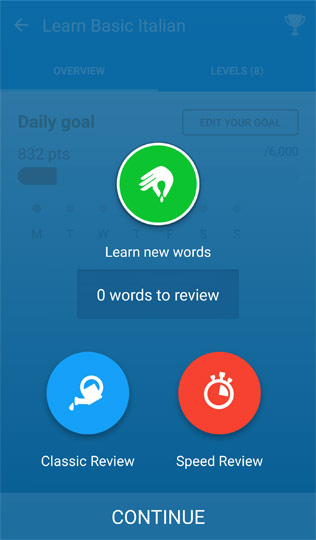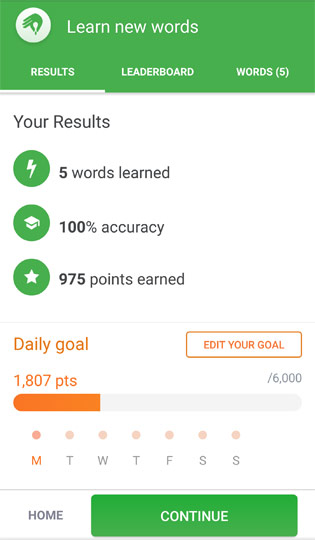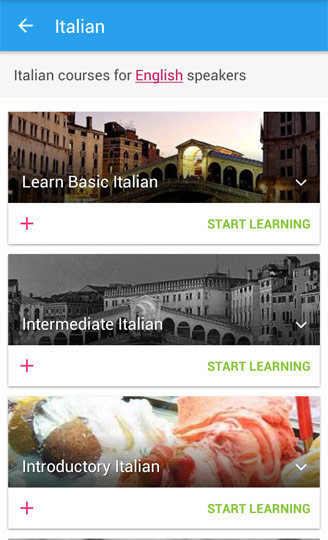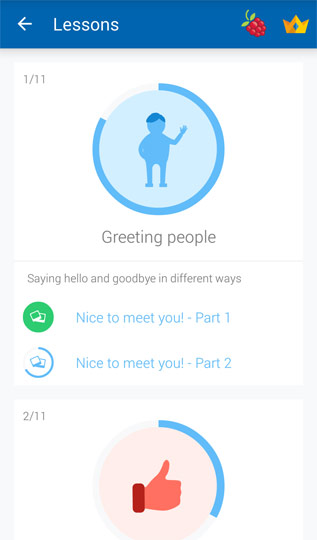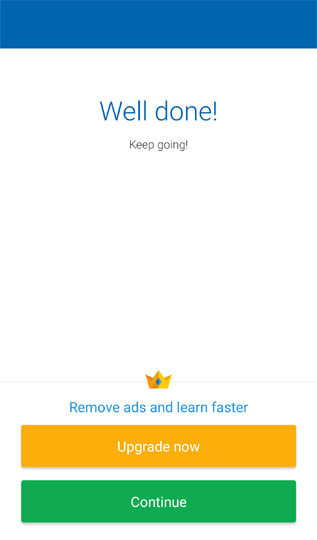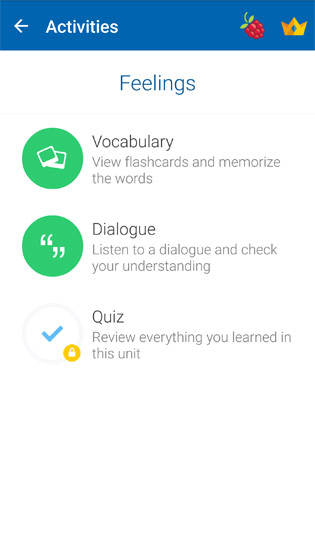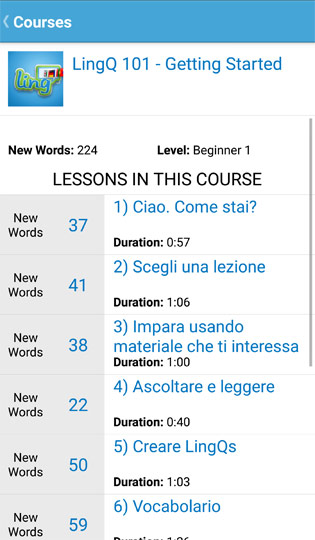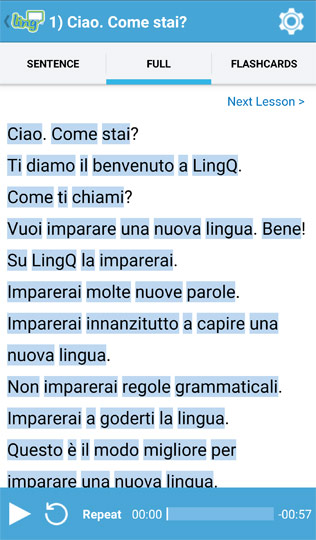Top 5 best free language apps to learn Italian before your next trip to Italy
For those of you who think that learning a new language is necessarily very time consuming, big ticket or just not in your wheelhouse, here are five free language apps that will definitely change your mind.
The top apps on this list will introduce you to the new language in a very entertaining way, without requiring to re-organize your daily or weekly routine or spending an arm and a leg.
While I can’t promise you that you will be 100% fluent in Italian in no time when using one of the apps in this list, I do guarantee you that the top apps on this list will make learning Italian (or any other language) enjoyable like never before and will also produce surprisingly fast results.
What makes the top best apps different from other language learning methods:
– Small window of attention
An app is something that I use by definition when I can’t open my laptop or a book, so often in situations where I can’t be fully concentrated more than 1 or 2 minutes at a time. As compared to other language learning methods and app will present you with bite-sized chunks that are easy to pick up and digest without completely losing attention of what is going on around you while you are commuting or queuing somewhere, for example.
– Fun and addictive
To be effective, your language learning method should be something you grab back to with pleasure. Learning a new language can be dull and repetitive at times, so playing and learning with an app is something that will help you overcome these ‘boredom barriers’ by offering something fun and addictive to play with.
– The right trade-off between repetition and motivation
Repetition is needed to fix certain concepts in your long-term memory, but too much repetition easily becomes very boring. Most of the apps in the list are designed in such a way that they keep you interested and motivated.
– Easy pick-up
The top apps in this list are designed in such a way that they make it easy for you to pick up where you left when you are being interrupted, both in terms of access (the way the apps are designed) and in terms of progress (units are small enough, so that you can always complete one in a short session and come back to start a fresh unit).
– User-friendliness
As compared to other language learning methods, with an app you can effectively start learning a new language within seconds. Sign-up is very fast and easy, and most apps also have an easy way to monitor your progress and see where you’re situated within the course (how much you have learned, how much there is left to complete a session or an entire level).
– Right balance between passive and active language use
The two first apps make use of the microphone (Duolingo), and include typing exercises in the target language (Duolingo and Memrise), which provides you a good balance between passive and active language use. This is not often the case with other language learning methods. It is one thing to learn to memorize words, to recognize and read them, it’s another to learn to how to pronounce and spell the words correctly and how to use them correctly in the right context. Too often, language learning methods concentrate the bulk of the exercises on passive language acquisition instead of active use. The fact that with an app you have a microphone and keyboard at your disposal makes it possible to balance passive and active language learning.
1. Duolingo
Duolingo consists of series of drill exercises constructed as a tree, in the sense that you have to complete each module before you can unlock the next one. The modules are called “skills” and introduce you to vocabulary units such as “food”, “colors”, “family”, “occupation” alternating with grammar units such as “plurals”, “questions”, “prepositions”. The modules consist of very short units which makes it easily possible to complete a unit during your daily commute or when you have just a few minutes to kill.
The exercises consists of translating short words or sentences, writing down what you hear, reading out aloud what you read and ticking the right answer among three or four options. The emphasis is on acquiring new vocabulary and understanding grammatical structures, rather than on pure memorization. A plus point is the little conversation bulb you can click at each exercise where you can find tips and comments by fellow students and moderators, which are often very helpful to explain nuances in the language you’re learning. Where Duolingo is different from the other apps is that you can access these to-the-point comments right from the exercise section, without having to go to the discussion section.
Duolingo encourages you to use the app on a regular (daily) basis by indicating your “on a x day streak” value next to your profile. This value indicates the number of days that you have been learning with Duolingo without interruption.
Duolingo beats the next app Memrise on two points: first, because it takes into account typos, counting your answer still as correct if you obviously made a typo, whereas Memrise counts anything that deviates from the correct answer as a mistake (except that it takes into account various translation possibilities).
Secondly, as I mentioned in the introduction, it also includes speaking exercises, where you have to record your answer, which is then matched against the correct answer, giving you also feedback on your pronunciation.
Too often, students keep progressing in vocabulary and grammar, without getting accustomed to the real-life pronunciation of the language, which creates a gap between the theoretical (passive) knowledge of the language and the active use of it.
The app allows to to set a daily goal going from:
– Casual (10 XP/day)
– Regular (20 XP/day)
– Serious (30 XP/day)
– Insane (50 XP/day)
The daily goals are translated into a graph showing your daily and weekly progress.
Right after you’ve signed up, you can choose between beginner level and a placement test, if you already have some basics in the language.
However, once started you can’t choose or skip topics or levels, you have to complete the Duolingo skills in the pre-determined order, even if there is something you don’t find interesting to learn (let say, the names of family members, for example). The only workaround is to take a short-cut, but short-cuts are only granted after passing a placement test.
However, once you have completed specific skills you can always repeat them whenever you like and the system will also remind you at regular time intervals when it is time to repeat specific skills.
Another drawback is the limited number of languages available. Besides Italian, there is Spanish, French, German, Portuguese, Dutch, Irish, Swedish, Danish.
Languages in Beta: Turkish and Esperanto
Languages in incubator: Norwegian (Bokmal), Ukranian, Romanian, Vietnamese, Polish, Hebrew, Klingon.
Aimed at: people who want a no-brain, easy-to-use app with modulable input, but maximum efficiency and a clear and well-defined methodology.
Available at: Apple App Store, Google Play Store, and Windows Store.
2. Memrise
Memrise is mainly centered around memorization. The exercises are therefore slightly different. Vocabulary and phrase structures are learned while memorizing examples. The units you learn are represented as seeds that are planted in your memory, which evolve into a flower once you have completed a unit and the word is fixed in your long-term memory. Memrise indicates at which interval you have to “water your plants” (read: reinforce the units in your memory).
You are asked to arrange words in the right order to reproduce a sentence and to select the right translation (in both directions) among four options. There are also spelling exercises which make use of an internal keyboard are also provided.
After completion of a section you can choose to go on learning new words or review what you have already learned. You can also chose to do a speed review.
Memrise beats Duolingo with its leaderboard, where you can monitor your own weekly, monthly and all time progress against the other Memrise community members using the same language module, which makes the app highly addictive. The fact that there is a weekly leaderboard allows you to eenter the competition right from the start.
Another nice Memrise feature are the “Mems” (mnemonics) provided by other Memrise members to help you remember the new words you are learning in a fun and effective way by association with an idea or pattern of letters that will make you easily remember the word. You can also submit your own Mems, but only from the website.
However, I have found that I have to go back to Duolingo from time to time to really “fix” the concepts in my memory with the right context and explanations.
You can choose your level and topics.
The app allows you to set a daily goal, going from:
– 1,500 pts/day corresponding to 5 mins a day
– 6,000 pts/day corresponding to 15 mins a day
– 20,000 pts/day corresponding to 20,000 45 mins a day
You can also choose to turn the goal setting feature off
One of the drawbacks may be that, unlike with Duolingo, you have a large choice of courses of different levels from which you can chose any to start with. My tip is to chose the suggested course on top or one of the courses with the highest numbers of users.
Memrise offers the largest collection of languages available.
Aimed at: people who want a little bit more freedom to choose what they study first and people who get their motivation from measuring their results against the community (leaderboard).
Available at: Apple App Store, Google Play Store, and Amazon App Store.
3. HelloTalk
Different from the previous two, HelloTalk is a chat app, aimed at people looking for language partners with whom to share live or text conversation. As opposed to other applications HelloTalk includes its own interface for texting and chatting, so you don’t have to resort to skype. Basically it’s like Whatsapp, but with an access to the entire user base instead of just your friends and acquaintances. Contrary to other social applications, the app is not designed to meet up with people afterwards, so it includes no reviews or ranking of the users.
The app includes a doodle share function (where you can draw what you are talking about when you don’t know the word in the target language), a spelling and grammar correction function, transliteration & voice recognition to help you write and speak your target language and the possibility to save an entire chat for future reference.
Available at: Apple App Store and Google Play Store.
4. Busuu
The method consist of short listening exercises; basically you view flashcards and have to memorize the words and then pick the right one from a list of three. Then you have an example of a dialogue (both written and spoken) that you have to reconstruct. There are also exercises where you have to drag words and match them with the right translation, or drag words to complete a dialogue that you have previously listened to. The exercises are a little more slow-paced than on Duolingo and especially Memrise, but that may be an advantage for certain people. This method looks very similar to the language courses I had 20 years ago in the language labs, which is a pity as an app could offer so much more variety and pulse. The design also seems a little outdated.
The main drawback is that you constantly receive reminders inviting you to upgrade to the paying Premium version. From the start, you can’t complete certain sections without paying for the Premium version. So, if you want to continue with the free version you often have to leave a section halfway and continue with the next one, and so on, or upgrade to the paid version. Really frustrating!
Also, unlike with Duolingo and Memrise you can’t practise what you have learned as the quizzes are locked in the free version.
Premium membership costs 8.99 Euro/month on a monthly basis or 4.08 euro/month on a yearly basis.
Adding more than two languages is only available in the premium version.
There are 4 levels: Beginner A1, Elementary A2, Intermediate B1, Upper Intermediate B2
Conclusion: Overall, Busuu is a little more “passive” in its language teaching approach. It also does not take full advantage of the specific elements that can be offered in an app. It is more slowpaced and traditional in its approach, like a typical handbook-tape course, whereas you would aspect a more dynamic approach with an app. Some quizzes are blocked in the free version.
Besides Italian the other languages available are: English, French, Spanish, German, Japanese, Chinese, Portuguese, Polish, Russian, Turkish
Where this app beats the two first ones, is that it provides interfaces for typing and speaking live with a native for free. However, you could easily use Duolingo or Memrise in a first stage and then HelloTalk when you start feeling a little more confident.
Aimed at: people who prefer a classic book-and-tape-like approach
Available at: Apple App Store and Google Play Store.
5. LingQ
In my opinion, this is the least stimulating and therefore also least effective of the language learning apps in this list. Still, it is a very comprehensive tool that may find supporters among the students who prefer a more traditional approach.
Basically, you are presented with a text, where words are highlighted in blue. You are supposed to listen to the text and check the words you don’t know by highlighting them in yellow for an explanation, after which you then decide to move them to your flash cards. When you’re done looking up the words you didn’t know, you can then click “I know all remaining blue words”. These words are then added to your “known words” database.
You can review what you have learned with flashcards and with “Cloze” (where you have to fill in the missing word). A nice feature is the fact that you can edit your flashcards within the app. Dictation and multiple choice exercises are available with the premium version.
The app makes it easy to select a learning level going from Beginner 1, Beginner 2, Intermediate 1 & 2 and Advanced 1 & 2.
While LingQ seems to be a very comprehensive tool, it completely misses out the purpose of an app, i.e. something that is fun to work with in the first place and that is easy to pick up no matter where I am or what I’m doing. If I can afford to be fully concentrated on what I’m doing for a longer period of time, then I might consider working with a book and CD, which gives me even more control and more in-depth-information, but that’s not what I’m looking for in an app, so an app that competes on the same level as a book and CD-method necessarily misses the point. LingQ requires a larger attention window, more input for a lower efficiency and yield. Actually, this app looks like it was first developed as a website and never was really adapted to become an app.
Available languages besides Italian: Swedish, English, French, Russian, Spanish, German, Portuguese, Japanese, Korean, Chinese, Dutch.
Beta languages: Arabic, Czech, Finnish, Esperanto, Hebrew, Latin, Norwegian, Polish, Romanian, Turkish, Ukrainian, Greek
Aimed at: people who prefer a more traditional approach.
Available at: Apple App Store and Google Play Store.
Conclusion:
The first two apps in this list, Memrise and Duolingo, are qualitatively very similar. From a linguistic point of view they are excellent tools to start learning a new language and they are both fun and easy to use. They offer intelligent drill exercises that introduce you in a fun way to new vocabulary, grammatical structures and idiomatic expressions. They promote both passive and active language learning.
Both Duolingo and Memrise are esthetically pleasing and addictive, with Memrise being even more addictive than Duolingo (but that may be a question of taste).
Duolingo and Memrise are by far the two best free language apps available. They complement each other very nicely, so I highly recommend to use both, should you decide to start learning Italian, as Italian is available in both. This will allow you to cross-test what you have learned with one app in the other one. Set your daily goal to something that you are sure to achieve each day, so that it will keep you motivated.
From an esthetic and motivational point of view I didn’t find Busuu and LingQ very usefull or effective, but I did mention them in the list because I can imagine that language learning methods are also for a part a matter of taste and habit, so if you are more into something that simulates classic learning methods one of them may be your choice.
HelloTalk is a nice app to try once you have completed Duolingo and Memrise and are ready to exchange a few words with other fellow students or native speakers. You don’t have to wait to be fluent in Italian to test your speaking skills, the more you practice the more you will pick up and that is true almost from the start.
Just give it a try and enjoy!
Looking for a more traditional method to complement your language learning app?
Here are our top picks:

